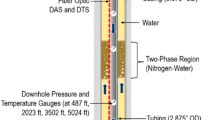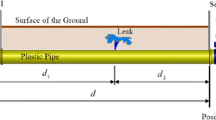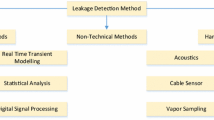Abstract
"Smart" sensors, with a fusion-based approach, pave the way for potentially changing how pipeline network systems are controlled, maintained, and monitored. This is typically done through structural modeling or spot monitoring using micro-electromechanical systems, strain gauges or through general conventional sensing. One of the challenges facing new developments in structural health monitoring (SHM) of a deployed asset is application to inaccessible locations. This work presents the use of a non-intrusive integrity monitoring sensor system utilising a multi-spectral approach to give more trusted insights to structural integrity as well as flow characteristics. The paper addresses the fundamental problems in identifying and characterising two-phase (air–water and oil–water) flow patterns and flow pattern transitions using numerous sensing techniques: strain gauges, optical Fibre Bragg Gratings, thermocouples (K-type), accelerometers, acoustic emission analysis and gyroscopes. By providing low noise, un-biased strain measurements, the non-intrusive sensor system can verify and improve integrity monitoring, providing a reliable alternative to conventional sensing. In addition, the non-intrusive sensor system enables pressure monitoring, providing flow assurance data and, provides good data integrity, making it an ideal tool as an enhanced surveillance strategy in real time for SHM of pipeline networks.














Similar content being viewed by others
References
Spencer, B.F., Ruiz-Sandoval, M.: Smart sensing technology for structural health monitoring. In: Earthquake Engineering, Canada (2004)
Alsaka Department of Enviorment Conservation: Technical Review of Leak Detection Technologies Crude Oil Transmission Pipelines (2004)
Cawley, P.: Structural health monitoring: closing the gap between research and industrial deployment. Struct. Health Monit. 17, 1225–1244 (2018)
Abd Murad, M. (ed.): 4th European-American Workshop on Reliability of NDE. The Development of Structural Health Monitoring (SHM) Procedures for the Structural Integrity and Maintenance Repair of Offshore Ageing Pipelines: NDT net (2009)
Li, J., Yang, X., Sitzenfrei, R.: Rethinking the framework of smart water system: a review. Water 412(12), 25 (2019)
Dai, F., Wang, D.: Analysis and comparison of long-distance pipeline failures. J. Pet. Eng. 2017, 1–7 (2017)
Santos, A., Younis, M.: A sensor network for non-intrusive and efficient leak detection in long pipelines. In: Proceedings of the IFIP Wireless Days Conference, Canada (2011)
Hopkins, P.: PIPELINES: past, present, and future. In: Asian Pacific IIW International Congress, Sydney (2007)
Zahab, S., Zayed, T.: Leak detection in water distribution networks: an introductory overview. Smart Water 4, 1–23 (2019)
Trans Mountain Pipeline spill in Abbotsford estimated at up to 190,000 litres of crude oil. CBC.ca. Retrieved 02 May 2021
MacLean, A., Moran, C.: Detection of hydrocarbon fuel spills using a distributed fibre optic sensor. Sens. Actuators A Phys. 109, 60–67 (2003)
Colombo, A., Karney, B.W.: Pipe breaks and the role of leaks from an economic perspective. Water Sci. Technol. Water Supply 3(1–2), 163–169 (2003)
Zou, L., Sezerman, O.: Pipeline Corrosion Monitoring by Fiber Optic Distributed Strain and Temperature Sensors, pp. 1–8. NACE International, Houston (2008)
Barry, A., Broaddus, D., Ivasauskas, J.: A novel solution for performing real-time fiber optic temperature measurements. SPE Int. 175047, 1–18 (2015)
Bolognini, G., Soto, M.A., Di Pasquale, F.: Simultaneous distributed strain and temperature sensing based on combined Raman–Brillouin scattering using Fabry–Perot lasers. Meas. Sci. Technol. 21(9), 094025 (2010)
Bado, M.F., Casas, J.R.: A review of recent distributed optical fiber sensors applications for civil engineering structural health monitoring. Sensors (Basel, Switzerland) 21(5), 1818 (2021)
Cataldo, A., Cannazza, G.: A new method for detecting leaks in underground water pipelines. IEEE Sens. 12, 1660–1667 (2012)
Adegboye, M.A., Fung, W., Karnik, A.: Recent advances in pipeline monitoring and oil leakage detection technologies: principles and approaches. Sensors (Basel, Switzerland) 19(11), 2548 (2019)
Ahadi, M., Bakhtiar, M.S.: Leak detection in water-filled plastic pipes through the application of tuned wavelet transforms to acoustic emission signals. Appl. Acoust. 71(7), 634–639 (2010)
Inaudi, D., Glisic, B.: Long-range pipeline monitoring by distributed fibre optic sensing. J. Press. Vessel Technol. 132(1), 011701 (2010)
Brown, G.: Downhole temperatures from optical fiber. Oilfield Rev. 4(20), 34–39 (2009)
Cusano, A., Breglio, G., Giordano, M.: Fiber Optic Sensing System for Smart Materials and Structures, pp. 1401–409. IEEE, Piscataway (2001)
Besagni, G., Inzoli, F.: Two-Phase Bubble Columns: A Comprehensive Review. MDPI, Chemengineering, London (2018)
Fang, L., Yang, Y., Fu, L., Wei, Z., Zhao, N., Li, X. (eds.): The Noise Characteristics of Gas-Liquid Two Phase Slug Flow in Vertical Pipe. IEEE, Piscataway (2018)
Pan, Y., Chen, Z., Xiao, L.: Application of Fiber Bragg GRating Sensor Networks in Oil Wells. SPE International, Issue 136978, pp. 1–6 (2010)
Wang, W., Song, H., Xue, J.: Overview of Intelligent Composites with Embedded FBG Sensors, pp. 47–51. Piscataway, IEEE (2011)
Hsu, N.N., Breckenridge, F.R.: Characterization and calibration of acoustic emission sensors. Mater. Eval. 39, 60–68 (1981)
Klein, L.A.: Multiple-sensor system applications, benefits, and design considerations. In: Edition, S. (ed.) Sensor and Data Fusion: A Tool for Information Assessment and Decision Making, pp. 9–52. SPIE Press, Anon (2012)
Ho, J.S., Li, Z.: Microwave Metamaterials for Biomedical Sensing. Elsevier Inc, Amsterdam (2015)
Liptak, B.: Do Multiple Sensors Improve Accuracy? [online] (2021). https://www.controlglobal.com/articles/2018/do-multiple-sensors-improve-accuracy/. 04/11/2021
El-Alej, M.E.: Monitoring Sand Particle Concentration in Multiphase Flow using Acoustic Emission Technology [online] thesis or dissertation (2014)
Shuib, H., Mba, D.: Acoustic emission of a single bubble activities. In: Proceedings of the World Congress on Engineering 2078-0958 (2010)
Narcy, M., Colin, C.: Two-phase pipe flow in microgravity with and without phase change: recent progress and future prospects. Interfacial Phenom. Heat Transf. 3(1), 1–17 (2015)
Alssayh, M., Addali, A.: Identification of two-phase flow regime using acoustic emission technology. Int. J. Mech. Production.. 16, 2320–2092 (2013)
Griffin, J.: Traceability of acoustic emission measurements for a proposed calibration method—classification of characteristics and Identification using signal analysis. Mech. Syst. Signal Process. 50–51, 757–783 (2014)
Husin, S., Addali, A.: Acoustic Emission for Monitoring Two-Phase Flow. EWGAE, Vienna (2010)
Alhashan, T., Addali, A.: Experimental investigation of the influences of different liquid types on acoustic emission energy levels during the bubble formation process. Int. J. Energy Environ. Eng. 9, 13–20 (2018)
Essid, M.: Monitoring sand Particle Concentration in Multiphase Flow Using Acoustic Emission Technology. PhD, Cranfield University, Cranfield (2014)
Bernasconi, Giancarlo & Del Giudice, Silvio & Giunta, Giuseppe: Pipeline Acoustic Monitoring. 1-7, 7th Pipeline Technology Conference, Germany (2012)
Droubi, M.G., Reuben, R.L., Steel, J.I.: Flow noise identification using acoustic emission (AE) energy decomposition for sand monitoring in flow pipeline. Appl. Acoust. 131, 5–15 (2018)
Droubi, M.G., Reuben, R.L., White, G.: Statistical distribution models for monitoring acoustic emission (AE) energy of abrasive particle impacts on carbon steel. Mech. Syst. Signal Process. 30, 356–372 (2012)
Ennaceur, C., Beaugrand, V., EWGAE.: 28th European Conference on Acoustic Emission Testing. Acoustic Emission Monitoring of Crack Growth in Dissimilar Joints for Corrosion Resistant Applications. Krakow, Poland (2008)
Sause, M.G.R. Investigation of Pencil-Lead Breaks as Acoustic Emission Sources. J. Acoust. Emis 29, 184 (2011)
Gath, I., Geva, A.B.: Unsupervised optimal fuzzy clustering. IEEE Trans. Pattern Anal. Mach. Intell. 11(7), 773–780 (1989)
Gosain, A., Dahiya, S.: Performance analysis of various fuzzy clustering algorithms: a review. Procedia Comput. Sci. 79, 100–111 (2016)
Klawonn, F.: Fuzzy clustering: Insights and a new approach. Mathw. Soft Comput. 11(2–3), 125–142 (2004)
Author information
Authors and Affiliations
Corresponding author
Ethics declarations
Conflict of interest
On behalf of all authors, the corresponding author states that there is no conflict of interest.
Additional information
Publisher's Note
Springer Nature remains neutral with regard to jurisdictional claims in published maps and institutional affiliations.
Rights and permissions
About this article
Cite this article
Zainal Abidin, D., Theminimulla, S., Waugh, D.G. et al. Applying a non-invasive multi-spectral sensing technique to two-phase flow measurements for pipeline monitoring. Int J Energy Environ Eng 13, 587–605 (2022). https://doi.org/10.1007/s40095-021-00471-4
Received:
Accepted:
Published:
Issue Date:
DOI: https://doi.org/10.1007/s40095-021-00471-4




